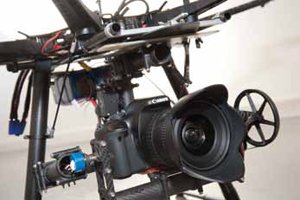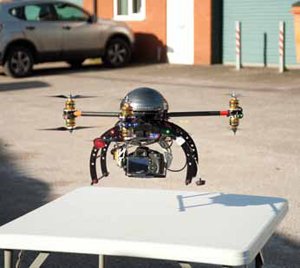articles/Equipment/remote-page3
Remote Control Aerial Platforms - part 3 of 1 2 3 4 5
by Mike McNamee Published 01/12/2012

A Canon D5 sits neatly in an articulated gimbal mount. These airframes are masterpieces of carbon fibre engineering.
Legislation
In our risk-averse world, it did not take the regulatory authorities long to take an interest in the development of 'model aircraft' and to slap a bunch of regulations down. If aerial photography is to be used and there is some financial gain involved then things get really rather heavy - licensing, flight logs, training and certification all suddenly crop up. This is not quite as draconian as it sounds and with even unpowered models capable of speeds a couple of points short of 500mph it is perhaps a good idea to regulate. The bottom line is that if you are going to take aerial images for gain you have to get all your insurance and regulatory ducks in line, the Civil Aviation Authority is likely to take a dim view of unauthorised flying, safe or otherwise.
Here is what we have learned so far on how to obtain a licence and perform 'aerial work'. Aerial work is defined as any activity using a remotecontrolled, unmanned aircraft in which the pilot ends the day financially better off than when they started. A pint of beer as recompense for a favour is considered OK, a crate of beer is not!
Assuming you have identified a business need for aerial work, the path to flying yourself is roughly as follows (but we suggest you to take advice right from the start):

Landing on a small table is a breeze for a qualified pilot!
1. You have to take a BNUC two-day groundwork school course at a cost of a little under £1,000 excluding expenses.
2. You have to produce an 'Operations Manual' which will set out how you intend to perform your intended work, define responsibilities, perform risk assessments, inform flight authorities, etc - overall how you are going to do everything, right down to the last detail.
3. Once the above has been sorted, you have to learn to fly. Many people start on a trainer airframe and/or flight simulators before progressing to their intended, larger rig. Once you are confident you have to apply for a flight test, which must be with the exact rig you intend to use, including the camera gear. This costs about £500.
4. Assuming you get through these hoops you then send your documentation off to the CAA to obtain your 'Permission for Aerial Work' and then you are good to go.
5. There is an ongoing requirement to keep a flight log (like any pilot), inform a control tower of any airfield you are proposing to operate close to and in any case you need to contact the local control tower (the one controlling the airspace you are flying within) to obtain clearance to fly above 400 feet.
Please Note:
There is more than one page for this Article.
You are currently on page 3
- Remote Control Aerial Platforms page 1
- Remote Control Aerial Platforms page 2
- Remote Control Aerial Platforms page 3
- Remote Control Aerial Platforms page 4
- Remote Control Aerial Platforms page 5
1st Published 01/12/2012
last update 21/07/2022 08:46:25
More Equipment Articles
There are 32 days to get ready for The Society of Photographers Convention and Trade Show at The Novotel London West, Hammersmith ...
which starts on Wednesday 14th January 2026










